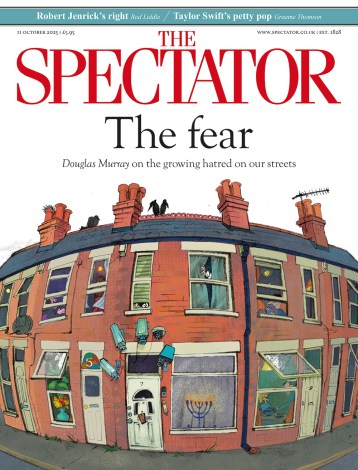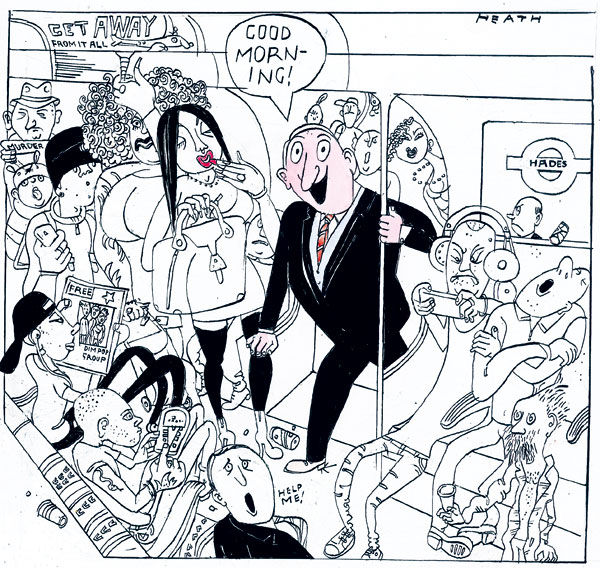You don’t have to live in London to be faintly obsessed by the Tube, but it probably helps. At this point I should state my bona fides: born in Great Ormond Street Hospital (nearest station: Russell Square), babyhood in Marylebone (Bakerloo line, originally to be called ‘Lisson Grove’), grew up in Hampstead (deepest station on the network with 320 steps down to the platform), and now live on the scabby side of Highgate, yards away from the disused overground line that once went to Finsbury Park. I am not a train-spotter as such, or even at all, but I do know to sit in the final carriage if I am getting out at Warren Street (that’s where the exit is) and that ‘Pimlico’ is the only station name that contains no letters from the word ‘badger’. You don’t want to be inside my head. I’m not sure I want to be.
Nonetheless, this may make me the ideal reader for Penguin’s 12 little books (priced at £4.99 each) about the London Underground, recently published under the general title ‘Penguin Lines’. Each is by a different author about a different line, most are between 70 and 90 pages long, and only Camila Batmanghelidh’s exceeds 128 pages. If you took one of these books for a long journey on the Central line, it might be worth taking another, just in case.
The excuse for publication is the 150th birthday of the Underground, which will be celebrated later this year, probably with a one-day strike by the RMT. But who needs an excuse? I’m not sure any of the writers did, such is the Tube-crazed gusto with which they have embraced their tasks. Whether some of them should have been chosen in the first place is another matter, but we’ll come to that.
The first thing to be said about these books is that they are beautiful, in a uniform design that makes you yearn to put them all on the same shelf next to each other. Next is that their homogeneity of look conceals a striking variety of subject matter, prose styles and political assumptions. John Lanchester’s What We Talk About When We Talk About the Tube is the line-and-length book of the set. His line is the District, so off he goes to Upminster to catch the 04:53, the only train to be found on the entire network before 5 a.m. Soon Lanchester has wangled it so that he can sit with the driver, and discovers they all prefer driving the older, near-the-surface lines like the Met and the Dictrict because there’s more to look at.
I love Lanchester’s non-fiction, in which category you could place at least a couple of his novels. He looks, he listens, he makes connections and he distils his findings into prose of enviable clarity. He is also a sucker for the trivial fact. In the US, trainspotters are known as ‘foamers’, because of their tendency to foam with excitement. Watching the Tube train wreck scene in Skyfall, Lanchester notices not only that the train is empty (not very likely at rush hour), but that it’s the wrong sort of train: a Northern Line train supposedly travelling along the District line. These things destroy verisimilitude faster than Javier Bardem’s unfeasibly blond hair.
No less entertaining is Peter York’s The Blue Riband, about the Piccadilly Line. York hadn’t been on the Tube for 25 years, and has no interest in the suburban bits at either end of the line: at one point he has to travel as far up as Arnos Grove, and we feel his pain. But on the great money zone in the middle, stretching from South Ken to Russell Square, he is fascinating, alive to every nuance and often very funny. He knows the price of everything, and the value of more than you might expect.
In John O’Farrell’s comic fantasy, A History of Capitalism According to the Jubilee Line, price and value become a matter of life and death. The power is off, a train is stuck in a tunnel between Waterloo and Canada Water, and water is seeping through from above. The passengers have to decide which way to walk. Should they go right, through the tunnel built and maintained by private enterprise, or left, through the tunnel looked after by Lambeth Council and London Transport? O’Farrell’s satire is clever and ingeniously plotted, although the fist fight between Roger Scruton and Noam Chomsky might be one gag too far. Murder your darlings, as ever.
If in doubt, though, write about yourself. The expat journalist Lucy Wadham, one of only three women on the list, contributes a pithy and action-packed memoir, Heads and Straights, of her bohemian youth in Chelsea in 1970s. It’s beautifully written and constantly surprising, but her greatest achievement may be not to mention the Underground once, even in passing.
William Leith’s A Northern Line Minute tells of his first journey back on the Tube after two years of such extreme anxiety he couldn’t even get himself onto a platform. As soon as he sits down he thinks he can smell smoke. It takes him 40 pages to travel from Belsize Park to Chalk Farm. Interior monologue is a narrative form favoured by bores and madmen, but Leith’s is hilarious and artfully constructed. He worries so that we don’t have to.
In A Good Parcel of English Soil the nature writer Richard Mabey takes on Metroland, where he grew up. It’s as elegant a piece as any here, a memoir enmeshed in social history, quietly taking the side of plants and animals against technology. There’s a polemical tinge, too, to Danny Dorling’s The 32 Stops. Dorling, an academic who favours the label ‘quantitative social geographer’, has written a series of fictional miniatures about people who live near stations on the Central line, drawn not so much from life as from a vast harvest of statistics. There are too many archetypes and received ideas, but you can’t help admiring his ambition.
Camila Batmangelidh’s Mind the Child is perhaps the greatest challenge here. Notionally about the Victoria line, it’s an out-and-out manifesto for the protection and nurture of vulnerable children, but we forgive her because she is clearly right. Her book is both eye-opening and far-sighted, and some of the children’s stories are unutterably sad.
Finally, the real oddities. In Waterloo-City, City-Waterloo, the US writer and illustrator Leanne Shapton delves into the minds of commuters on their daily slog. Although she often gets the vernacular wrong, her ideas are glorious, and the graphic and photographic ways she represents people’s thoughts are splendidly inventive. By contrast, Philippe Parreno’s Drift, purportedly about the Hammersmith & City line, is a series of ink drawings with no meaning or purpose that I could identify.
The rock writer Paul Morley’s memoir of the Bakerloo line, Earthbound, has less to say than almost any other book here, and uses many more words to say it. And Buttoned Up, an exercise in high-fashion drivel by a couple of Dutchmen who trade under the name ‘Fantastic Man’, spins 108 pages out of the idea that ‘everyone’ is wearing shirts done up to the top without a tie in east London. ‘The self-consciously thought-through pubs of Hackney and Tower Hamlets, with their junk-shop decor and continuing investigation into the aesthetics of the wrong, are dotted with compelling top-button wearers.’ As long as they’re all having fun, eh?






Comments